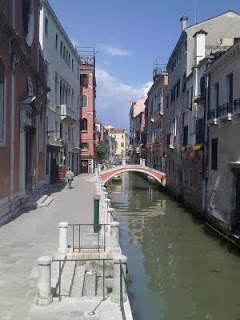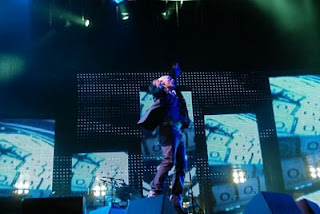Streets flooded. Please advise LOL
They do say that the best way to see Venice is not to plan a proper route and just explore the maze of narrow streets, canals and alleyways not knowing what you're about to stumble upon. My problem is that I'm not very good at aimless wandering. For example, upon exiting the station on day 1, I resolved to follow the Grand Canal as it looped around to the Rialto bridge before heading down to the main Piazza San Marco (St Mark's Square to you); within 10 minutes I was frantically breaking out the guidebook after following the wrong canal.
On day 2, after a few minutes of making my casual way through the sidestreets towards the Accademia gallery, I got antsy that I didn't know exactly where I was and ended up following the ubiquitous signs down to the Rialto instead. Even though going via there was a much longer route.
Sigh.
Still, you're never entirely sure what's what in Venice, wherein lies its charm. Away from San Marco and the obvious tourist traps (and there are lots of tourists), you can be walking down a shabby alleyway one minute, only to turn the corner into a wider street whose buildings, despite the similarly dilapidated facades, contain chic beauticians and art shops.
The sheer amount of noteworthy buildings and spots means that you're bound to stumble upon something unexpected. Such as the Santa Maria Gloriosa dei Frari, an enormous church that even as Catholic churches of this vintage go is spectacularly ornate. It reminded me of a central message from Kenneth Clarke's Civilization documentary series, now being repeated on the BBC HD channel, in that the majority of great historic art and architecture was created in religion's name. (The series could only be improved were it to be remade by the modern-day Ken Clarke, strolling past all these fantastical artworks with big stogie in hand.)
The Basicila di San Marco is similarly insane - even bigger with nearly every wall, floor and ceiling covered by intricate mosaic art. Although one has to say that the smaller cross-sections of mosaic on display in the museum bit do look somewhat cartoony and shit - proof that such things are meant to be viewed, and worshipped, from a distance.

The adjacent Doge's Palace is something of an exception to the above rule, offering similar levels of eye-boggling spectacle despite being a secular building. The council chambers in particular are almost comically cavernous, until you remember that for so long Venice was an economic powerhouse and therefore all the filthy-rich nobles wished to celebrate it as such. Between this place and the Basilica, Venice must have used up virtually all the Middle Ages' quota of gold-leaf paint.
Interestingly, throughout most of the glory days the Doge himself had extremely limited powers, the role merely requiring him to be a figurehead for the general population to celebrate. In one of those not quite perfect coincidences, I visited the Palace the day after the Royal Wedding...
I was disappointed by the Gallerie dell'Accademia, which provides a potted history of Venetian art from the Middle Ages. Sadly, half of it is under renovation at the moment, and although the building is old and venerable it didn't really seem all that conducive a space for displaying art, however impressive some of the works may be.
Fortunately both the Peggy Guggenheim and the Punta della Dogana modern art collections were far more up my alley. My relationship with art can at best be described as sporadic, but on the basis of these I'm rapidly coming to the conclusion that in fact modern art does more for me than the old-fashioned stuff (although I'd still like to retain the right to dismiss a good portion of it as bollocks). The Punta in particular is a fantastically bright and airy space which enhances and in many cases eclipses the works themselves.
There are also several other islands in the Venetian lagoon (great word, lagoon) and it's worth visiting one or two of those if only to give you the opportunity of sampling a water bus. These literally operate as water-based buses and despite how busy they are, travelling by sea is always more fun than doing so by land even with the increased risk of drowning. The water taxis and gondolas, while offering somewhat more privacy, cost an absolute fortune and hardly appeared worth bothering with.
The islands themselves can helpfully be classified along the same lines as Friends episodes - there's Murano (The One with the Glassmaking), San Michele (The One With the Cemetery), the Lido (The One with The Beaches. I went and managed not to find a beach, which is another story), etc.
One aspect of Venice I can't really comment on is the quality of the bars and restaurants. Obviously if I hadn't been on my own then I'd have enjoyed spending a couple of evenings trawling these. One thing the guidebooks emphasise is that the city isn't known for its pulsating nightlife, but then again I can't imagine many folk coming here expecting superclubs and suchlike. I can report that at least one bar shows Premier League matches, however (hey, I'd been on my feet for the best part of nine hours at that point, so I felt fully entitled to go and do English stuff for a bit).
In a nutshell, however many museums, galleries and churches it boasts, Venice is one big floaty island museum, the locals being one of the main exhibits. Walking through the alleys and along the canals you see all sorts of doorways to what can only be peoples' houses, some of which appear to be in such disrepair that surely nobody would be living in them, but of course people do - in spite of the floods, and the tourists. They ensure that Venice remains a genuinely unique place and not a fossilised relic. Molte grazie.





Comments